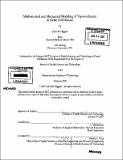Mathematical and mechanical modeling of vaso-occlusion in sickle cell disease
Author(s)
Higgins, John M. (John Matthew)
DownloadFull printable version (1.691Mb)
Other Contributors
Harvard University--MIT Division of Health Sciences and Technology.
Advisor
L. Mahadevan.
Terms of use
Metadata
Show full item recordAbstract
Vaso-occlusive crises cause most of the morbidity and mortality associated with sickle cell disease. The proximal causes of these occlusive events are not well understood. The risks and consequences of vaso-occlusion however are clear. Ten percent of sickle cell disease patients will have a stroke by the age of 20. Two thirds of sickle cell disease patients require more than one hospitalization per year for treatment of pain crises. The flow behavior of blood samples from sickle cell patients was studied in an artificial microfluidic environment. This microfluidic environment allowed modulation of the hydrostatic pressure causing flow, the ambient oxygen concentration, and the vascular channel geometry. A range of blood samples was evaluated by selecting specimens with various hematocrits and concentrations of sickle hemoglobin. Velocity profiles were calculated following sudden changes in oxygen concentration. From these profiles, it was possible to create a phase space of vaso-occlusion in the artificial microfluidic environment. This phase space characterizes the environmental conditions in which sickle cell blood will stop flowing within a given interval of time. (cont.) This work is a first step in characterizing the inter-relationships between some of the control parameters governing vaso-occlusion: pressure, oxygen concentration, channel size, hematocrit, and sickle hemoglobin concentration. This artificial device enables a quantification of the effect of a clinical therapy, red blood cell exchange, as performed on an actual sickle cell patient. Additionally, three sample small molecules known to alter rates of sickle hemoglobin polymerization were evaluated for their ability to perturb the tendency of sickle cell blood to stop flowing. These results suggest a possible application of this technique to the diagnosis and monitoring of sickle cell patients as well as to the investigation of new regimens of existing treatments and altogether novel therapies.
Description
Thesis (S.M.)--Harvard-MIT Division of Health Sciences and Technology, 2007. Includes bibliographical references.
Date issued
2007Department
Harvard University--MIT Division of Health Sciences and TechnologyPublisher
Massachusetts Institute of Technology
Keywords
Harvard University--MIT Division of Health Sciences and Technology.